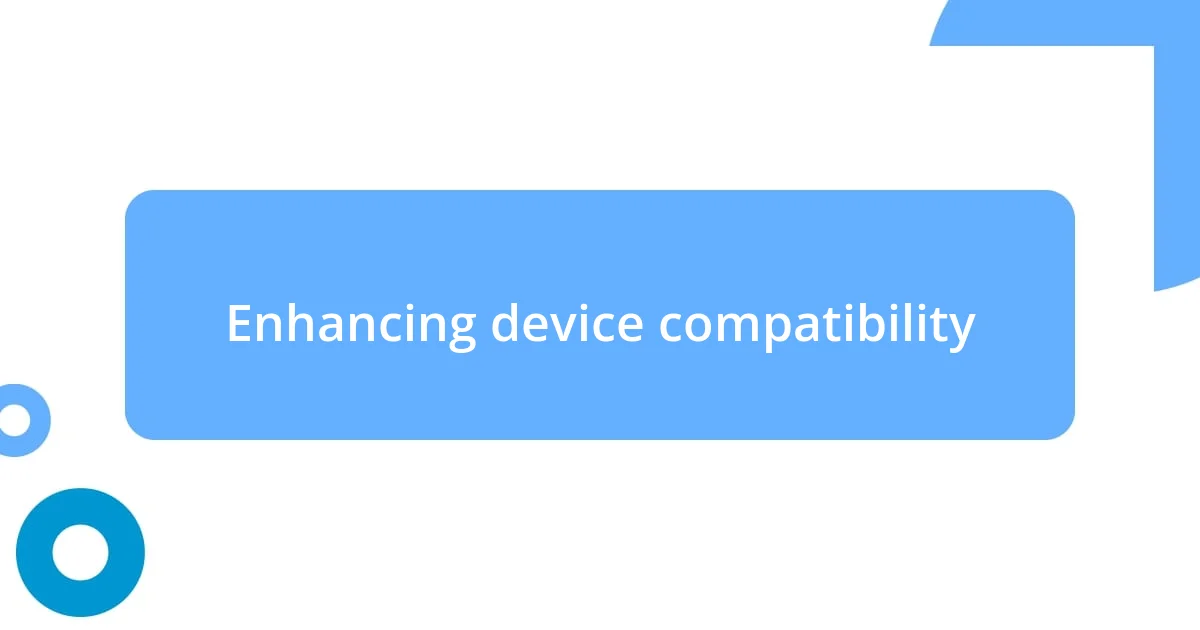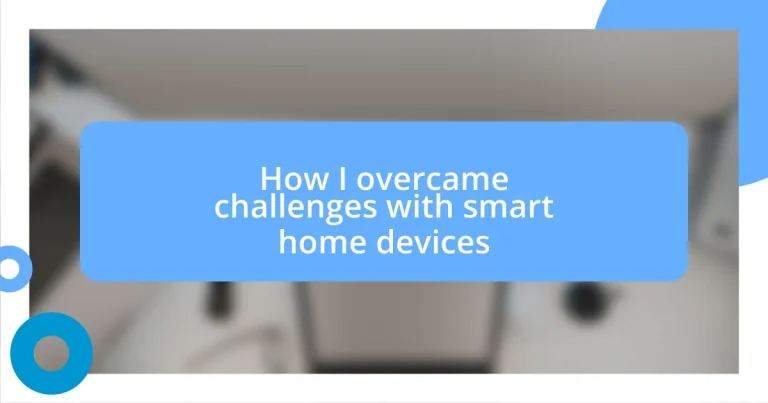Key takeaways:
- Smart home devices significantly enhance daily routines by automating mundane tasks, resulting in greater comfort and efficiency.
- Common challenges include compatibility issues, a steep learning curve for setup, and privacy concerns, all of which can be mitigated with proper research and planning.
- Prioritizing device security through updated firmware, unique passwords, and separate networks is essential for maintaining a safe smart home environment.

Understanding smart home devices
Smart home devices are like the helpers we never knew we needed until they showed up. Picture this: I was struggling with managing my daily tasks, from remembering to turn off the lights to adjusting the thermostat. One evening, I realized I could automate these functions with smart devices, and it felt like a weight had been lifted off my shoulders.
These devices range from smart speakers to security cameras, all designed to simplify our lives. I remember the first time I set up my smart assistant; it felt like I was stepping into the future. Have you ever thought about how much time we spend on mundane tasks? With a simple voice command, I could control my home, and I began to wonder how I ever lived without it.
Understanding smart home devices goes beyond just knowing their functions; it’s about how they can enhance our daily routines and provide comfort. I can’t help but smile when I think about how my smart lighting system adjusts to my mood; it’s like having a personal ambience creator at my command. Isn’t it fascinating how technology can integrate so seamlessly into our lives, almost like an invisible support system?

Identifying common challenges
Identifying common challenges with smart home devices can be an eye-opening experience. For instance, when I first dove into the world of smart gadgets, I encountered the frustrating maze of compatibility issues. I remember trying to connect various devices from different brands, only to face the reality that they just wouldn’t play well together. It felt like I was trying to get a cat and a dog to share a bed—an exercise in patience!
Another hurdle I stumbled upon was the learning curve associated with smart device setup. I recall the first time I attempted to connect a smart thermostat. The instructions seemed straightforward, yet I found myself confused by technical jargon and unnecessary steps. Did you ever feel if you could just have a simple tutorial, things would fall into place? That’s how I felt, and it made me realize how crucial it is to have user-friendly guides.
Lastly, I encountered privacy concerns that made me pause. As much as I enjoyed the convenience of smart speakers, I couldn’t shake the feeling that they were always “listening.” This realization sparked a bit of anxiety, balancing my desire for convenience with the need for security. Have you ever had that moment where convenience clashes with your comfort zone? It’s an important consideration for anyone venturing into the smart home realm.
| Challenge | Description |
|---|---|
| Compatibility Issues | Devices from different brands often do not work seamlessly together. |
| Learning Curve | Setting up devices can be daunting due to complex instructions. |
| Privacy Concerns | Smart devices may raise questions about data security and user privacy. |

Strategies for successful setup
Setting up smart home devices doesn’t have to be a daunting task if you approach it with a plan. I vividly remember the satisfying moment of organizing all my devices in one app. It made navigating the smart home landscape so much easier. A little pre-setup research can go a long way. You might want to:
- Check compatibility before purchasing devices to ensure they will work together.
- Create a dedicated network for your smart devices to avoid interference with personal devices.
- Follow a step-by-step guide or video for instructions, which can clarify complex setups and processes.
Another strategy I found invaluable was involving my family in the setup process. I thought it would be a headache, but instead, it turned into a bonding experience. Each family member had the chance to express their preferences, and it made the transition smoother. Plus, having everyone on board meant fewer confusion and issues down the line. Here are some tips to consider:
- Designate roles for each family member for specific tasks to streamline the setup.
- Test each device as you set it up, ensuring each function works properly before moving on.
- Create a shared document or video walkthrough to help everyone stay informed on device operation.
Trust me, these strategies not only ease the setup stress but also transform the entire experience into something enjoyable.

Overcoming connectivity issues
When I first set up my smart home devices, the connectivity issues felt insurmountable. I vividly remember one evening when my smart lock decided it wouldn’t connect to my Wi-Fi. Picture me, standing at my front door, juggling groceries and my keys, determined to figure it out while my dinner grew cold. It was a lesson in patience and troubleshooting, but I learned to check the signal strength and even reposition the router—a game changer for avoiding dead zones.
One surprising revelation I had involved leveraging device placement. I found that simply moving my smart home hub a few feet made a world of difference. Have you ever noticed how the layout of your home can affect device performance? I once had a smart bulb that wouldn’t respond consistently. After some tinkering, I realized its location was critical—moving it nearer to the hub reduced the lag time dramatically.
Lastly, I can’t stress enough the importance of network capabilities. I invested in a mesh Wi-Fi system to extend my signal throughout the house. This was particularly useful when my kids started using their tablets for online classes—it was as if a light bulb lit up in my head! Have you experienced that eureka moment when everything finally works harmoniously? It felt fantastic knowing my devices wouldn’t freeze or drop connection mid-kitchen dance party, enhancing both my smart home experience and daily life harmony.

Enhancing device compatibility
To enhance device compatibility, I learned early on that doing a bit of homework beforehand pays off significantly. I recall researching the different standards like Zigbee and Z-Wave, which helped me understand which devices could easily communicate with each other. Have you ever felt that rush of confidence when you know you’re making informed choices? It transforms the entire shopping experience into something empowering.
Another aspect I found crucial was firmware updates. It sounds technical, but keeping my devices up to date was like giving them a refresh button. I once overlooked an update for my smart thermostat, thinking it was running just fine. Shortly after, I encountered compatibility issues with a new sensor. After updating the firmware, everything synced beautifully, and I couldn’t help but marvel at how a small action dramatically improved my device compatibility.
I also came to appreciate the benefits of using a unified ecosystem. Embracing a single brand for my smart devices simplified not just the setup but also day-to-day use. For instance, I chose a smart speaker that seamlessly integrated with my lights and thermostat. It’s amazing to ask one device to control another; it felt like I was living in the future! When everything works in harmony, has there ever been a more satisfying feeling than straightforward control over your living environment?

Maintaining device security
Maintaining the security of my smart home devices has been one of my top priorities. I remember the unsettling moment when I realized my security cameras weren’t as secure as I assumed. After doing some research, I quickly changed default passwords and enabled two-factor authentication. Have you ever felt that weight lift off your shoulders knowing you’ve taken steps to secure your devices? That immediate shift in peace of mind was worth the time spent.
Another pivotal step for me was regularly updating my device firmware. Once, I neglected to check for updates on my smart home hub for weeks, and I began experiencing odd glitches. As soon as I realized the updates included vital security patches, I felt a mix of relief and regret. It’s a small yet critical reminder that an ounce of prevention is worth a pound of cure—especially when it comes to protecting your home.
I also discovered the importance of segmenting my network. I created a separate Wi-Fi network just for my smart devices, isolating them from my personal devices like laptops and smartphones. This way, if one device were compromised, it wouldn’t give attackers access to everything. Isn’t it empowering to take control of your digital space like that? It’s not just about convenience; it’s about making informed choices that enhance both security and usability in my home.

Maximizing smart home efficiency
To maximize smart home efficiency, I’ve found that automation is a game changer. For example, I set up routines so that my lights gradually dim and my thermostat adjusts to a cozy temperature about an hour before bedtime. Have you ever experienced that sense of relief knowing everything is working in sync? It’s like your home is anticipating your needs, which not only saves energy but also creates a welcoming atmosphere.
One particularly eye-opening moment for me was when I realized the importance of energy monitoring. After installing a smart plug, I was amazed to see how many devices were using power when I wasn’t even home. Tracking this data motivated me to unplug devices that weren’t in use, leading to noticeable savings on my energy bill. Isn’t it satisfying to not only gain insight into your habits but also take actionable steps that benefit both your wallet and the environment?
I’ve also learned the value of voice control for efficiency. Initially, I was skeptical about it—could a voice command really be more effective than flipping a switch? But when I tried using voice commands to turn off lights while I was already tucked in bed, it felt revolutionary. Suddenly, I wasn’t just saving time; I was creating a more comfortable routine that allowed me to relax without getting up. How often do we overlook such small tweaks that can significantly enhance our daily lives?














